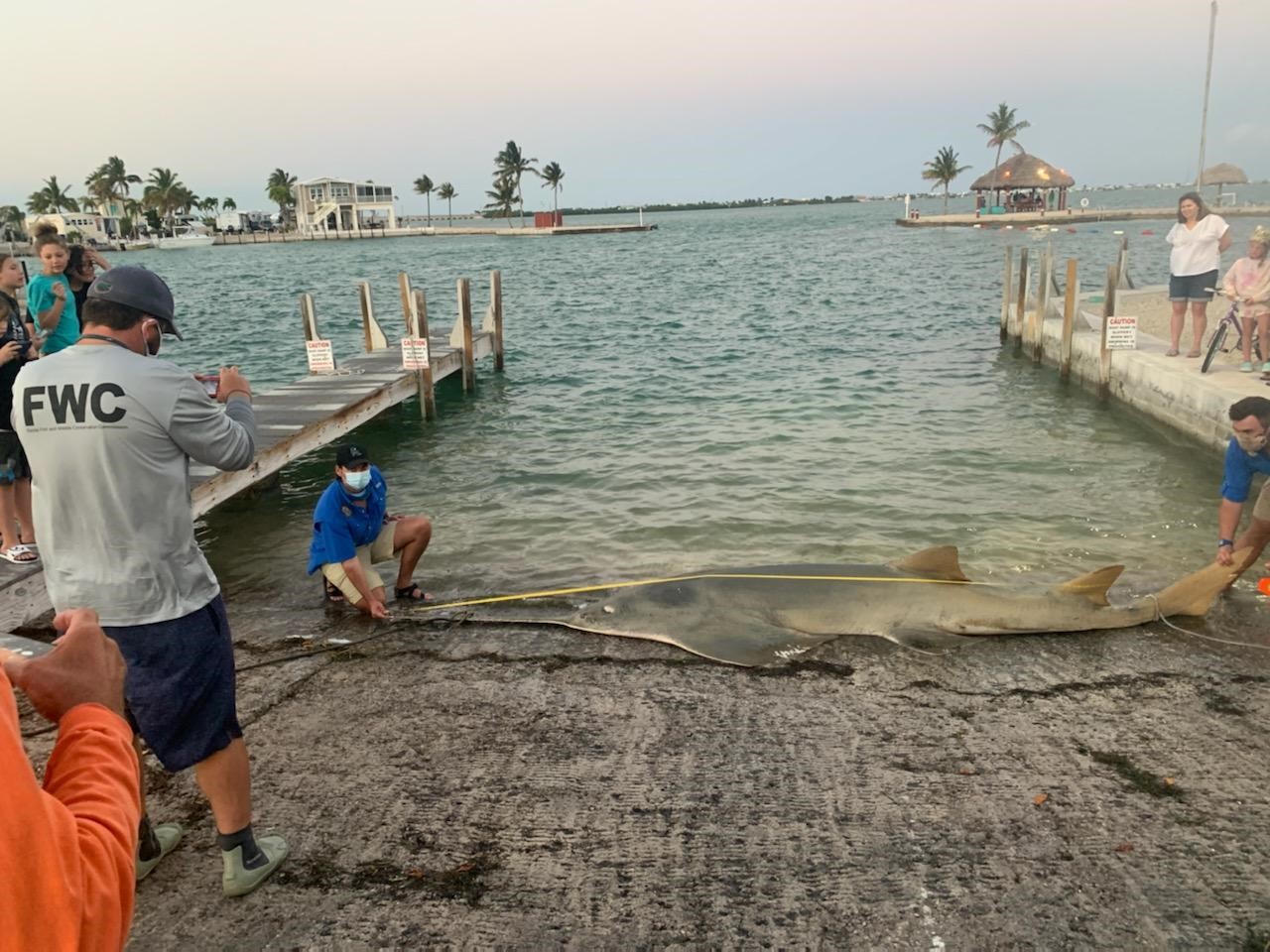Largest recorded smalltooth sawfish washes up dead in Florida
The 16-foot female sawfish had softball-size eggs in her reproductive tract.

The largest sawfish ever measured by scientists was found dead in the Florida Keys last week.
The 16-foot-long (4.9 meters) sharp-snouted fish was a mature female with eggs the size of softballs found in her reproductive tract. Scientists are now studying her carcass to determine her age and to learn more about her reproductive past.
"Although it's a sad occurrence when a big animal like that dies, from a scientific standpoint we knew we could learn a lot from it," said Gregg Poulakis, a fish biologist at the Florida Fish and Wildlife Conservation Commission. "That makes us feel a little bit better about having lost such a big female."
Related: See photos of the largest fish on Earth
Studying sawfish
The record-breaking sawfish was one of two dead sawfish that washed ashore in the Keys last week, one near Cudjoe Key and the other near Marvin Key. They were found far enough apart that the timing of their deaths is most likely coincidental, Poulakis told Live Science.
Citizens reported the fish via the Commission's sawfish hotline, and local law enforcement helped tow the carcasses to shore so that researchers could measure them and take tissue samples. Sawfish have been on the Commissions' research radar since 2003, when they were added to the U.S. federal endangered species list. (All five species of sawfish are also listed as endangered or critically endangered by the International Union for Conservation of Nature.)
Sawfishes are a kind of ray fish known for their flat, chainsaw-like snouts. Little was known about them before their endangered species listing, Poulakis said.
Sign up for the Live Science daily newsletter now
Get the world’s most fascinating discoveries delivered straight to your inbox.
"Basically, any question you could ask — 'How big do they get?; what kind of habitat do they need?; how long do they live' — we just didn't have an answer," he said.
Now, Poulakis and other collaborators within the Commission and at other Florida research agencies regularly catch,tag and release sawfish along the coast. They also get about 20 to 30 reported sightings a month from boaters and fishers. Five or six times a year, a dead sawfish washes ashore. Even carcasses that have partially decomposed are scientifically useful, Poulakis said: Rays' vertebrae show a growth line each year, much like a tree trunk, so by slicing the calcified cartilage and counting the lines, scientists can tell how old the animal was when it died.
A sawfish matriarch
The oldest sawfish studied by Poulakis' team so far was 14 feet (4.7 m) long and 14 years old. The smaller of the two sawfish found dead last week was 12 feet, 4 inches (3.8 m) long and was still a juvenile, Poulakis said. She had immature eggs in her ovaries. The 16-foot sawfish, on the other hand, was a mature adult.
"We're excited to see how old the 16-footer that we got this week is," Poulakis said last week. "My guess is that she is older than [14]."
The two sawfish had no injuries or other indications of why they had died, Poulakis said.
The researchers are studying the reproductive tracts of the fish to understand more about when they reach maturity. Sawfish pregnancies last approximately a year, Poulakis said, and they give birth to live young measuring about 2.5 feet (0.7 m) long.
The researchers also plan to take DNA samples, which they can compare to the DNA of the juvenile sawfish that they catch to look for relationships along the maternal line. They'll also check the animals for parasites to understand the baseline parasite load in a sawfish's body.
Anyone in Florida who sees a sawfish should report the sighting to the state sawfish hotline, Poulakis said. Sightings can be reported by phone at 844-4SAWFISH, by email at sawfish@myfwc.com, or via the FWC reporter app.
Originally published on Live Science.
Editor's note: This article has been updated to indicate this record is for the largest smalltooth sawfish, which is one of five sawfish species. Also, the article was updated to correct the reference to "bone," which is actually calcified cartilage.

Stephanie Pappas is a contributing writer for Live Science, covering topics ranging from geoscience to archaeology to the human brain and behavior. She was previously a senior writer for Live Science but is now a freelancer based in Denver, Colorado, and regularly contributes to Scientific American and The Monitor, the monthly magazine of the American Psychological Association. Stephanie received a bachelor's degree in psychology from the University of South Carolina and a graduate certificate in science communication from the University of California, Santa Cruz.










